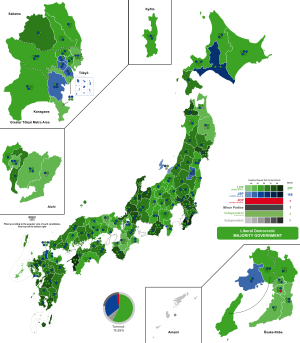General elections were held in Japan on 22 May 1958. The result was a victory for the Liberal Democratic Party, which won 298 of the 467 seats.[1] Voter turnout was 77.0%.
| |||||||||||||||||||||||||||||||
All 467 seats in the House of Representatives 234 seats needed for a majority | |||||||||||||||||||||||||||||||
|---|---|---|---|---|---|---|---|---|---|---|---|---|---|---|---|---|---|---|---|---|---|---|---|---|---|---|---|---|---|---|---|
| Turnout | 76.98% ( | ||||||||||||||||||||||||||||||
| |||||||||||||||||||||||||||||||
 Districts shaded according to winners' vote strength | |||||||||||||||||||||||||||||||
| |||||||||||||||||||||||||||||||
The Japan Socialist Party only ran 246 candidates. The Japanese Communist Party, which strategically withdrew some of its candidates in favor of the JSP in the 1956 elections, ran 114 candidates.[2]
This election had the highest turnout for a post-war election so far.[3]
Results
edit| Party | Votes | % | Seats | +/– | |
|---|---|---|---|---|---|
| Liberal Democratic Party | 22,976,846 | 57.80 | 287 | –10 | |
| Japan Socialist Party | 13,093,993 | 32.94 | 166 | +6 | |
| Japanese Communist Party | 1,012,036 | 2.55 | 1 | –1 | |
| Other parties | 287,991 | 0.72 | 1 | – | |
| Independents | 2,380,795 | 5.99 | 12 | +6 | |
| Total | 39,751,661 | 100.00 | 467 | 0 | |
| Valid votes | 39,751,661 | 99.27 | |||
| Invalid/blank votes | 290,828 | 0.73 | |||
| Total votes | 40,042,489 | 100.00 | |||
| Registered voters/turnout | 52,013,529 | 76.98 | |||
| Source: Mackie, Masumi | |||||
By prefecture
edit| Prefecture | Total seats |
Seats won | ||||
|---|---|---|---|---|---|---|
| LDP | JSP | JCP | Others | Ind. | ||
| Aichi | 19 | 10 | 8 | 1 | ||
| Akita | 8 | 5 | 2 | 1 | ||
| Aomori | 7 | 4 | 2 | 1 | ||
| Chiba | 13 | 10 | 3 | |||
| Ehime | 9 | 8 | 1 | |||
| Fukui | 4 | 3 | 1 | |||
| Fukuoka | 19 | 12 | 7 | |||
| Fukushima | 12 | 7 | 4 | 1 | ||
| Gifu | 9 | 5 | 4 | |||
| Gunma | 10 | 7 | 3 | |||
| Hiroshima | 12 | 9 | 2 | 1 | ||
| Hokkaido | 22 | 11 | 11 | |||
| Hyōgo | 18 | 10 | 7 | 1 | ||
| Ibaraki | 12 | 8 | 4 | |||
| Ishikawa | 6 | 5 | 1 | |||
| Iwate | 8 | 5 | 2 | 1 | ||
| Kagawa | 6 | 4 | 2 | |||
| Kagoshima | 11 | 8 | 2 | 1 | ||
| Kanagawa | 13 | 6 | 7 | |||
| Kōchi | 5 | 4 | 1 | |||
| Kumamoto | 10 | 7 | 3 | |||
| Kyoto | 10 | 6 | 4 | |||
| Mie | 9 | 5 | 4 | |||
| Miyagi | 9 | 5 | 4 | |||
| Miyazaki | 6 | 4 | 2 | |||
| Nagano | 13 | 7 | 5 | 1 | ||
| Nagasaki | 9 | 5 | 3 | 1 | ||
| Nara | 5 | 2 | 1 | 2 | ||
| Niigata | 15 | 8 | 6 | 1 | ||
| Ōita | 7 | 5 | 2 | |||
| Okayama | 10 | 6 | 4 | |||
| Osaka | 19 | 11 | 7 | 1 | ||
| Saga | 5 | 3 | 2 | |||
| Saitama | 13 | 9 | 4 | |||
| Shiga | 5 | 2 | 3 | |||
| Shimane | 5 | 3 | 2 | |||
| Shizuoka | 14 | 10 | 4 | |||
| Tochigi | 10 | 6 | 4 | |||
| Tokushima | 5 | 3 | 2 | |||
| Tokyo | 27 | 12 | 15 | |||
| Tottori | 4 | 3 | 1 | |||
| Toyama | 6 | 4 | 2 | |||
| Wakayama | 6 | 4 | 2 | |||
| Yamagata | 8 | 6 | 2 | |||
| Yamaguchi | 9 | 6 | 3 | |||
| Yamanashi | 5 | 4 | 1 | |||
| Total | 467 | 287 | 166 | 1 | 1 | 12 |
Notes
editReferences
edit- ^ Dieter Nohlen, Florian Grotz & Christof Hartmann (2001) Elections in Asia: A data handbook, Volume II, p381 ISBN 0-19-924959-8
- ^ Cole, Totten & Uyehara 1966, pp. 65.
- ^ Cole, Totten & Uyehara 1966, pp. 64.
Works cited
edit- Cole, Allan; Totten, George; Uyehara, Cecil (1966). Socialist Parties In Postwar Japan. Yale University Press.

